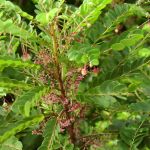| Common Name: |
Myrobalan |
| Other Names: |
Black Chebulic, Haritaki |
| Botanical Name: |
Terminalia chebula |
| Genus: |
Terminalia |
| Family: |
Combretaceae |
| Location: |
Sri Lanka, India, Myanmar (Burma), and Nepal. |
| Cultivation: |
Fertile, sandy soil in sun. |
| Propagation: |
By seed sown when ripe at 18-24°C (64-75°F); by layering in spring. |
| Harvest: |
Fruits are collected when ripe and sun-dried for use in decoctions, pastes, and powders. |
| Height: |
15-25m (50-80ft) |
| :Width |
20m (70ft) |
| Hardiness: |
Min. 16-18°C (61-64°F) |
| Parts Used: |
Fruits (he zi) |
| Properties: |
A sweet, astringent, warming herb, with and unpleasant taste; it regulates colon function, improves digestion, is expectorant, controls bleeding and discharges, and destroys intestinal parasites. It also has a tonic, rejuvenative effect, especially on the digestive, respiratory, and nervous systems. |
| Medicinal Uses: |
Internally for constipation, digestive and nervous disorders, diarrhea, dysentery, intestinal worms, hemorrhoids, rectal prolapse, abnormal uterine bleeding and inflammation, vaginal discharge, involuntary ejaculation, coughs, night sweats, and asthma. Externally for ulcers, wounds, mouth inflammation, and gum disease. |
| Culinary Uses: |
Sour fruits are eaten fresh in salads, pickled in brine, or fried; also used to make "black salt" which is an essential ingredient of a spice blend known as chat masala.
| Economic Uses: |
Dried fruits are used in tanning and inks. |
| Warning: |
Not given to pregnant women or patients with severe exhaustion or dehydration. |
| Bibliography: |
Encylopedia of Herbs by Deni Brown Copyright ©: 1995, 2001 Dorling Kindersley Limited pg 384
|
|

